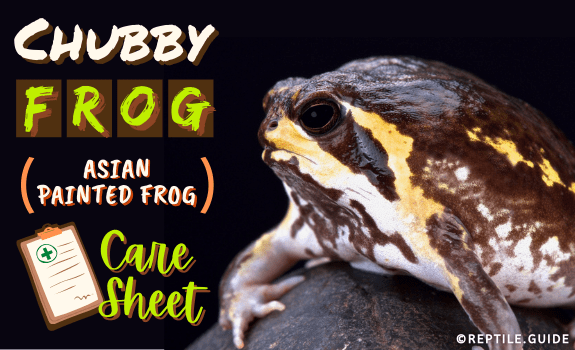The chubby frog (Kaloula pulchra) is also known as the Asian painted bullfrog, banded bullfrog, or painted bullfrog.
These plump, adorable amphibians belong to the narrow-mouth frog family (Microhylidae).
Chubby frogs may not be the most active of pets, but they are hardy, require relatively little space, and can do exceptionally well in captivity.
Their simple care requirements and endearing appearance have made them among the most popular frogs in the pet trade.
In This Article
What You’ll Learn
In this article, you’ll learn everything you need to know about painted bullfrog care, including:
- What to feed chubby frogs
- How to house chubby frogs
- Environmental requirements
- How often to feed chubby frogs
- Background information about the species
…and much more!
Chubby Frog Background Information
Asian painted frogs (Kaloula pulchra) are native to the tropical forests of Southeast Asia.
Their native range encompasses much of the region, including East India, Bangladesh, Myanmar, Malaysia, China, Hong Kong, Vietnam, Cambodia, Thailand, and Lao People’s Democratic Republic.
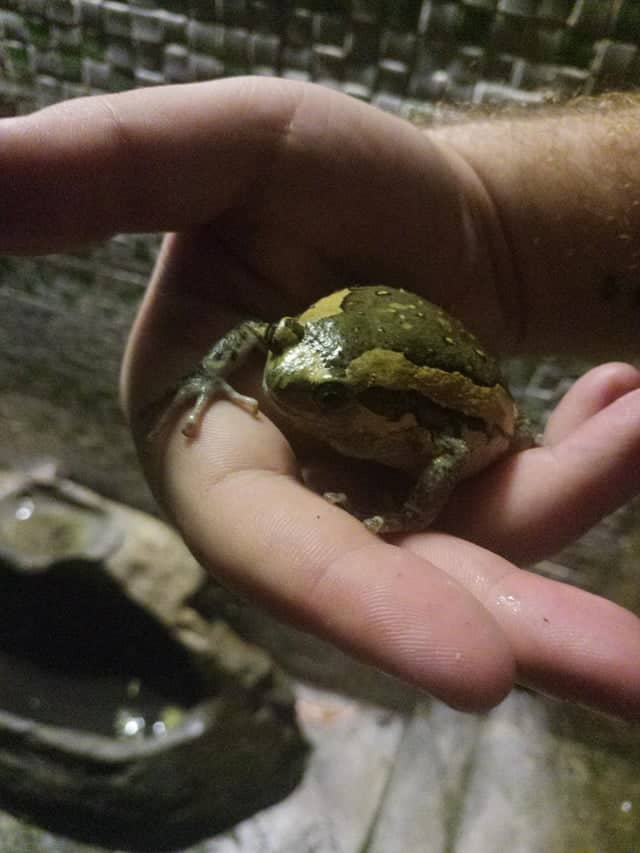
You can find a great map of their range at the Berkeley Natural History Museum’s mapping page (just don’t ask us about that frog 200 miles off the coast of Mexico. We haven’t got a clue either!).
As an exotic invader, the chubby frog has been slowly taking the world by storm.
In addition to their long list of native countries, they’ve been accidentally introduced to many other tropical areas.
South Florida, the Philippines, Guam, and Singapore are a few countries now known to harbor chubby frog populations.
As quite an adaptable species, they seem to do well in human-inhabited areas and rice paddies.
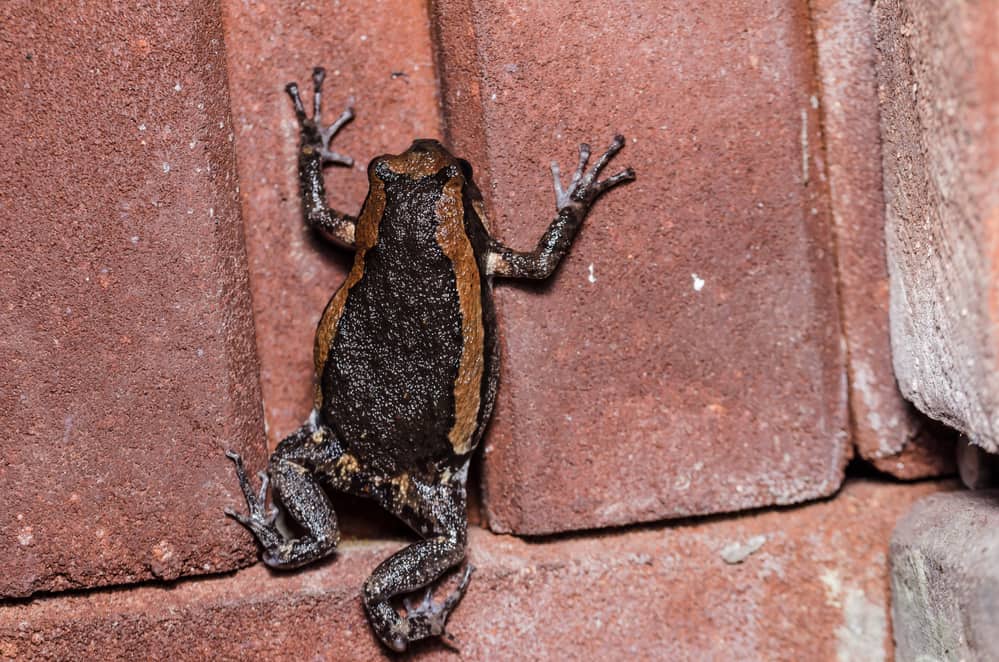
This fact is partly why they seem to have done so well outside of their native range.
Description
Chubby frogs are – as their name suggests – a robust species. They have short, stubby limbs and a large rounded body.
This round body shape is typical of narrow-mouthed frogs (microhylids).
Adults usually grow to two to three inches in length.
Their overall coloration is usually a dark brown, with a beige or off-white belly.
As their other names suggest, banded bullfrogs or painted frogs also possess a thick band running along either side of the body.
These bands can range from a rusty brown to almost salmon pink.
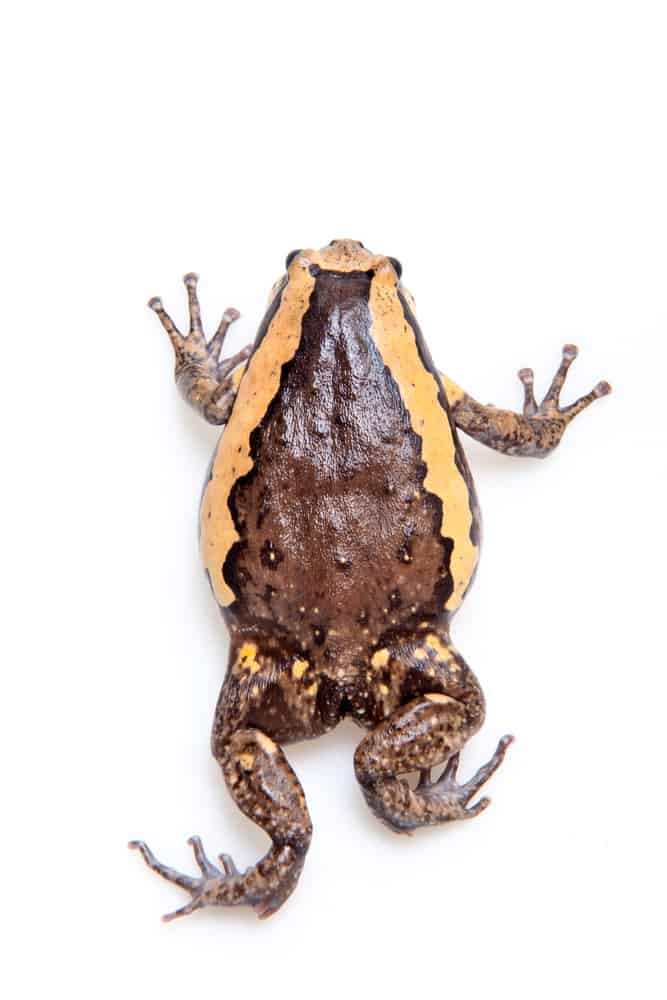
Males also possess a noticeably dark throat patch. Females’ throats are light in color.
Biology
The chubby frog or painted bullfrog (Kaloula pulchra) is a secretive, nocturnal frog species.
They spend most of their ten-year lifespan buried in leaf litter or burrowing in loose soil, away from the inquisitive eyes of scientists.
Their shy nature makes it nigh-on impossible to glean much information about the species’ habits in the wild.
What we do know is that banded bullfrogs are ant specialists (though they’ll happily eat many other small insects).
You’ll often find these frogs hunkered down beside anthills for an all-you-can-eat insect buffet.
Another fact that’s been easy to uncover is that these frogs are LOUD for their small size.
They remain virtually silent throughout most of the year, until the arrival of the monsoon season.
After the first heavy rain, they gather in shallow pools on the forest floor to emit a cacophony of bellowing noises.
Vast numbers of these frogs can amass during each short breeding season (think Woodstock but with chubby frogs).
People even mistake the call of courting chubbies for a herd of cattle!
Chubby frog breeding pools are temporary and can dry up quickly.
This time pressure has driven the evolution of an expedited development process to help them to survive.
These turbo-charged tadpoles can achieve complete metamorphosis in as little as two weeks!
Conservation
The chubby frog is lucky in that it adapts well to human-managed habitats.
Despite ongoing changes to the landscape of Southeast Asia, these frogs continue to thrive.
Though their status has not been reviewed since 2004 (and may need an update), K. pulchra populations seem stable throughout their range.
They may even be increasing, despite large numbers being harvested annually for the pet trade.
The IUCN lists K. pulchra as a species of “Least Concern.” This designation means that they are not currently believed to be at risk of extinction.
From a conservation perspective, these frogs may be more of a pest than a pity case!
They spread like wildfire in consistently moist habitats due to their rapid rate of reproduction.
Populations have established themselves in many other parts of Southeast Asia (outside of their native range) and tropical areas of South Florida.
Over time, these tenacious frogs could begin to threaten native species in their new environments.
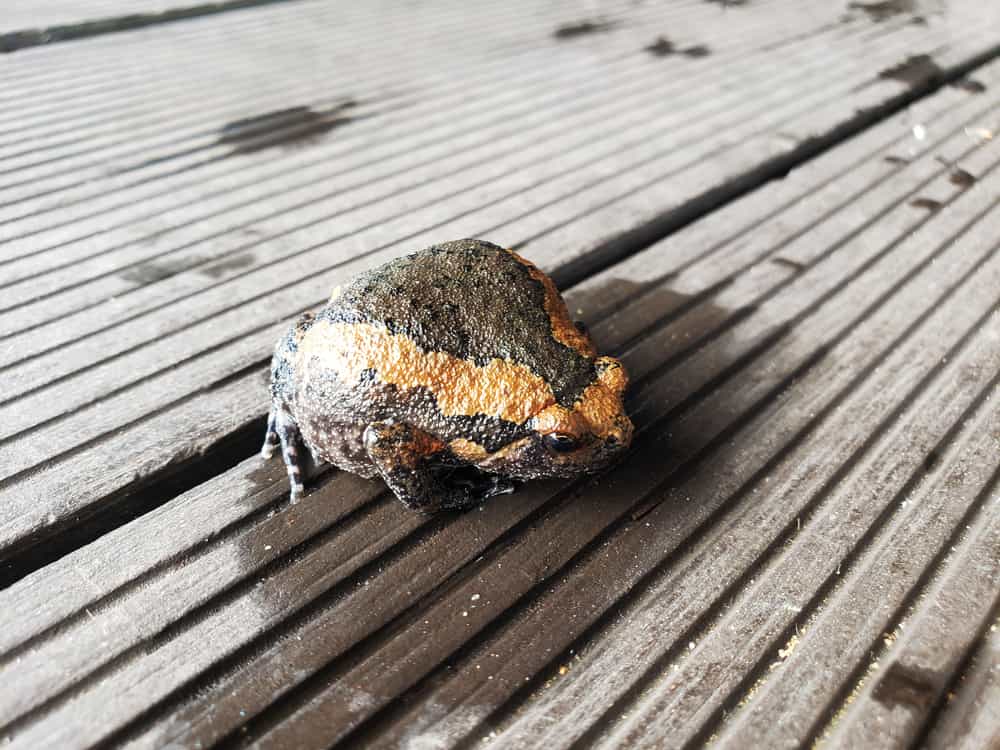
Purchasing a Chubby Frog Pet
Chubby frogs can be great for beginners. Their husbandry needs are simpler than many other frogs.
They make for an easy pet if you are already familiar with amphibian care.
Any new amphibian owner must be committed and willing to do plenty of research to ensure their animal’s welfare.
You’ll often see chubby frogs advertised for sale in pet stores and at reptile expos. Sellers may label them as “painted bullfrog” or “Asian painted frog.”
The vast majority of chubby frogs in the pet trade are wild-caught specimens. We recommend searching for a reputable breeder in your area.
Buying directly from a chubby frog breeder has some advantages over purchasing from pet stores.
Firstly, pet stores stock a vast diversity of animals, which can mean that staff are only trained to provide the bare minimum amount of care advice to new keepers.
Amphibians have different requirements from other kinds of pets.
A lack of information at the point of sale can often lead to accidental neglect down the line and an unhappy frog!
A good breeder will likely be far better equipped to answer your questions.
They’ll know the species’ specific care requirements inside and out and make it their business to ensure that you’re in on all of the tips and tricks relating to Asian painted frog husbandry.
Another significant advantage of shopping directly from a breeder is that you can have peace of mind, knowing that your animal has been captive-bred.
This way, you know that you aren’t contributing directly to the removal of frogs from the wild.
The harvest of wild animals harms frog populations in their native range.
Wherever you choose to shop, it’s essential to check for signs of good health when selecting a frog to take home.
Good indicators of a well-kept and healthy frog include:
- Moist skin
- Bright eyes
- Overall responsiveness
- Activity (though don’t rely on this, as the chubby frog is an EXTREMELY sedentary animal!)
We recommend that you avoid purchasing animals with any of the following red flags:
- Unresponsiveness
- A dirty or crowded enclosure
- External parasites, skin lesions, or discoloration
Chubby Frog Tank
Asian painted frogs are tropical, terrestrial amphibians. They require a warm, humid environment with room to burrow and hide within their enclosure.
Thankfully, unlike some amphibians and reptiles, the chubby frog requires only a small space to remain happy and healthy.
This trait makes them considerably cheaper to house than more active exotic animals.
In this section, you’ll learn how to select a suitable chubby frog enclosure.
Enclosure Size and Shape
For chubby frogs, we recommend a wide, rectangular enclosure with at least ten gallons of volume.
Banded bullfrogs are a ground-dwelling – or terrestrial – species.
Though they can climb (somewhat), chubby frogs require more horizontal than vertical space in their enclosures.
This terrestrial nature means that their enclosure’s width should exceed its height.
For more active frogs of a similar size – such as the red-eyed tree frog – a much larger vivarium would be required. Thankfully, these frogs don’t really do much.
A ten-gallon tank (e.g., 24 x 9 x 13 inches) is roomy enough for this species, but 15 gallons or more is ideal.
You can comfortably house up to three adult chubby frogs in one 15-gallon enclosure.
Type of Enclosures
A standard glass vivarium is ideal for this species. Plastic vivariums are also a perfectly viable option.
Glass tends to conduct heat well, while plastic is cheaper and more lightweight. The choice comes down to keeper preference.
We don’t recommend keeping these frogs in wooden terrariums, as they require high humidity levels that can lead to mold buildup.
For this same reason, your frog’s enclosure must be well-ventilated.
Select an enclosure with a partially vented lid if possible.
If you have a fully-mesh lid, you may have trouble maintaining sufficient humidity.
If so, you can cover part of the mesh lid with a ceramic tile or similar item to reduce moisture loss.
It’s vital to leave some mesh uncovered to ensure that your frog still receives plenty of airflow.
Chubby Frog Environmental Requirements
Once you’ve purchased an enclosure, it’ll only take a short while to get things set up for your new frogs.
This section will teach you how to create and maintain an ideal environment to allow your chubby frog to thrive.
The primary considerations for any amphibian setup are:
- Lighting
- Substrate
- Humidity
- Temperature
- Vivarium accessories
- Whether to keep frogs alone or in groups
Don’t plan on picking up a frog until you understand each of these requirements.
If something goes wrong, you should have already purchased (and tested) the equipment before bringing one home!
Ideal Temperature Gradient
Asian painted frogs are a tropical species. They require heating above average room temperature to survive in captivity.
The ideal temperature range for this species is around 75 to 80 degrees Fahrenheit during the day.
At night, reduce this to between 68 and 70 degrees.
Like most other amphibians, chubby frogs have extremely sensitive skin and are vulnerable to desiccation (drying out). Avoid using heat lamps for this species.
We also recommend AGAINST using a heating pad beneath your frog’s enclosure.
These frogs do like to burrow, and this method can lead to the frog coming into direct contact with the glass (or plastic) terrarium floor, causing burns.
Instead, a great way to heat your frog’s enclosure is by attaching a heating pad to the exterior wall at the back of the enclosure.
Insulate the pad with a polystyrene tile to radiate heat into the enclosure and prevent loss to the outside.
As with all other amphibian and reptile setups, you MUST control your heat pad using a thermostat to prevent overheating.
You should also include a thermometer in your enclosure. This tool will allow you to monitor and adjust day and night time temperatures.
Ideal Humidity Levels
Chubby frogs require an ambient humidity level of around 70% at all times.
Ensure that your enclosure contains a working hygrometer to monitor humidity levels.
Ambient humidity is primarily dependent on your misting schedule and choice of substrate.
A large, shallow water bowl can also help maintain a humid environment through evaporation.
Keep your frog’s substrate moist by misting the enclosure daily. The substrate should remain slightly damp but never become saturated.
Wet substrate can encourage mold growth and the proliferation of disease-causing bacteria.
When misting, use only distilled or dechlorinated water. Chlorine and other additives can damage your frog’s health.
You should also select an appropriate substrate to properly retain and diffuse moisture. We’ll discuss this in detail in the following section.
Substrate
Chubby frogs require three or four inches of substrate to line the floor of their enclosure. This deep layer will provide plenty of room to burrow.
Burrowing provides animals with behavioral enrichment as well as shelter.
Both of these needs are essential to prolong your animal’s lifespan and help to reduce stress.
The substrate also serves a vital function in maintaining the ambient humidity of your enclosure.
Coconut fiber is the most popular substrate choice for amphibians – and for good reason. It retains moisture well and is relatively cheap and easy to find.
Some keepers also incorporate fine potting soils or compost into their setups.
Potting soil substrates are excellent for burrowers but don’t retain moisture well. Instead, they turn to mud when wet.
Mosses (usually sphagnum moss) are great additives that help your substrate mix retain more humidity.
Though it’s a little pricey, sphagnum moss is excellent for absorbing moisture.
You can also experiment with a surface layer of leaf litter, sphagnum moss, or sheet moss to enhance the aesthetics of your enclosure.
A diverse surface layer also provides additional hiding spots.
A mix of coconut fiber and a small amount of potting soil seems to work well for these frogs.
For a bit of help with cleaning, add some microfauna – such as isopods or springtails.
These critters feed on detritus, reducing the buildup of bacteria and mold. They can also contribute to the humidity of the enclosure.
You can also purchase so-called “bioactive” substrate mixes ready-made.
Never use sand or gravel in your substrate mix. Ingesting these substrate particles can cause impaction and ultimately harm your frog’s digestive system.
Lighting
Chubbies require no specific lighting.
They do benefit from a natural day/night cycle.
To achieve this, just place your frog’s enclosure within the sight of window.
Expert Tip: Never place an enclosure in direct sunlight, as this can lead to overheating.
Alternatively, you can set up a simple aquarium light above your chubby frog tank, attached to a timer.
Fluorescent lighting will allow you to include live plants (if desired) and enhance your enclosure’s aesthetic appeal.
Ensure that your lights are not too intense as they may dry out a frog’s delicate skin.
If they do raise the temperature of your vivarium a little, lower your heat pad thermostat setting to compensate.
Decor and Accessories
Nobody wants to stare at a bare tank, especially not your frog!
These animals spend most of their time holed up beneath litter and debris in their native habitat.
Provide a range of hides to help your frog to feel more at home in its environment.
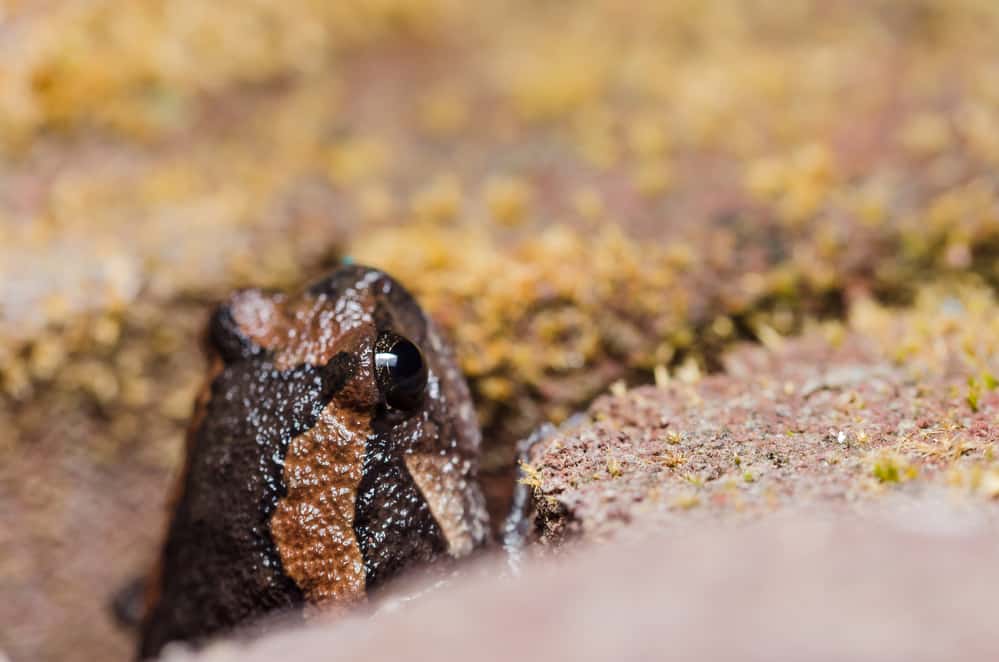
Excellent hides for this species include:
- Cork flats
- Flat stones
- Bark pieces
- Commercial hides (appropriately-sized)
Some keepers also choose to include plants – either live or artificial – to enhance the look of their vivarium.
Planting a chubby frog habitat can make for an eye-catching display.
Remember that these frogs love to burrow!
They’ll quite happily uproot your plants and make a real mess in the process. Bear this in mind when selecting your plants.
The other thing to consider is that you will need some kind of specialist lighting to keep your plants alive. Fluorescent aquarium lights are great for this purpose.
You’ll also have to pot your plant or use a plant-friendly substrate in the enclosure.
Of course, artificial plants have the obvious advantages of not requiring any care or equipment.
If you do want to use live plants to enhance your vivarium, check out our list of reptile and amphibian-friendly vivarium plants for inspiration.
Keeping Frogs in Groups
Frogs are very sociable animals and should be kept in groups of two or three. This housing arrangement will serve as a form of behavioral enrichment.
Frogs are unlikely to breed unless provided with specific environmental conditions, so you don’t have to worry about male and female frogs multiplying if kept together.
We’ll talk about the conditions required to breed these frogs later on in this article.
Chubby Frog Food
Asian painted frogs are members of the narrow-mouthed frog family, Microhylidae.
As this name suggests, they have narrow mouths in relation to their body size.
Since they do not possess large, gaping jaws – like Pacman frogs or White’s tree frogs – they cannot take large prey.
Instead, chubbies require a fully insectivorous diet.
In this section, we’ll walk you through the chubby frog diet.
We’ll also include some basic information about frog nutrition to help you care for your animals properly (and avoid common mistakes).
To learn even more about amphibian dietary habits, check out our articles on what frogs eat and what toads eat.
You can also learn the differences between frogs and toads here.
The Basics – What You Need to Know About Frog Diets
For proper care of insectivorous frogs and reptiles, there are some things keepers must be aware of, namely:
- Vitamin D3
- Micro- and macro-nutrients
- The Calcium-to-Phosphorous (Ca:P) ratio
“Macro” nutrients are the key components that should make up most of a frog’s diet. These are:
- Ash – All parts of an insect’s body besides the other nutrients listed below. Contains several micronutrients.
- Lipids – Energy-rich fats and oils. They fuel your frog’s metabolism but can cause obesity if quantities are too high.
- Fiber – Undigestible material. Aids the passage of food through the gut, maintaining digestive health.
- Protein – Helps to maintain muscles and promote growth.
“Micro” nutrients are vitamins and minerals. While still essential, these needn’t be supplied in such large quantities for a frog to thrive.
Calcium and Vitamin D3 are the two micronutrients that you – as a keeper – should be most aware of.
Both are essential for healthy bone growth and should be supplied regularly in supplement form.
Without D3, your frog is unable to utilize calcium.
A deficiency in either nutrient will prevent your frog from maintaining its skeletal structure and nervous system.
Another thing that can prevent your frog from correctly processing its calcium intake is an excess of phosphorous.
This balance is known as the Ca:P ratio and must be kept at around 1.5 to 1.
Feeder Insects
Though Asian painted frogs are ant specialists, they also seem to love small crickets.
Crickets are the best feeder insects for most insectivores due to their excellent Ca:P ratio, relatively high protein contents, and low lipid content.
They are a great choice of chubby frog food and can serve as a staple in your animal’s diet.
Never try to feed your frog crickets that are too large to fit in its mouth.
Inappropriately large crickets may fight back and injure your frog. They seem to prefer slightly smaller crickets than other frogs their size.
For added diversity, you can throw in some mini mealworms, wax worms, or small grasshoppers every three or four feeds.
Avoid offering lipid-rich foods – such as mealworms and wax worms – too often. An excess of these foods can cause your frog to become obese.
You should also gut-load your feeders for at least 48 hours before offering them to your frog. Doing so helps to boost their nutritional content.
Especially-formulated mixes are available from reptile stores for this purpose. A mixture of fruits and veggies can also serve the same purpose.
Supplements
Dust your feeders with a generous amount of powdered calcium immediately before feeding.
Offer a multivitamin mix containing vitamin D3 around once per week, also by dusting.
Wild frogs benefit from a diverse and nutrient-rich diet.
Unfortunately, it’s not logistically feasible to feed a frog the same breadth and quality of food available in the wild.
You must offer your captive frogs regular supplements in addition to their staple diet of nutritious, gut-loaded insects.
Calcium and D3 are the most essential additions to your frog’s diet, but multivitamin mixes (formulated for amphibians) will include other nutrients for an overall nutritional boost.
Water
Provide your frog with a large, shallow water bowl and keep it topped up at all times.
Ensure that this bowl is not easily tippable, as your frog may try to burrow underneath it.
Also, make sure that the bowl is not too deep for your frog to climb out of.
Constant access to a source of clean water is vital for your frog’s health. Clean and refill the bowl regularly, especially when soiled with feces or dead insects.
How Often to Feed Your Frog at Any Age
Feed adult chubbies every other day.
They typically will eat two or three medium-sized crickets per feed.
Feed juvenile frogs every day.
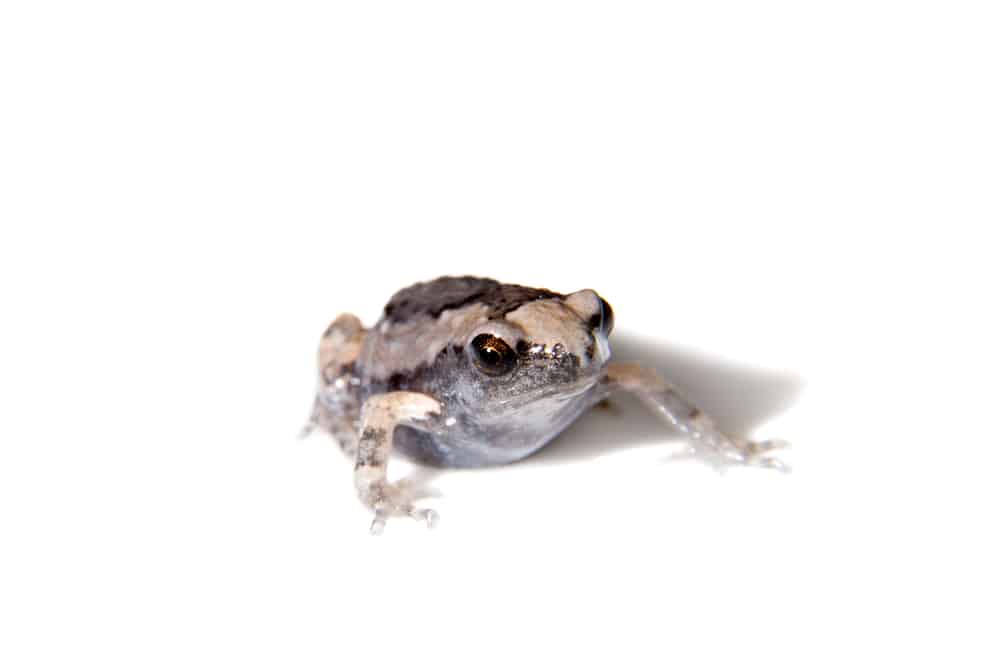
Chubby Frog Health Information
Intestinal Impaction
Intestinal impaction is a fairly common health problem faced by captive frogs.
It occurs when animals consume indigestible material – such as substrate – in large quantities.
Cases of impaction can range from mild to severe.
Mild cases are usually treatable at home. Still, it’s always best to prevent this condition from occurring in the first place.
To prevent impaction, only use fine particulate substrate in your frog’s enclosure. Be sure to avoid using gravel and sand.
If you do come across large particles in your substrate mix, you should remove these if possible.
Only feed appropriately sized prey. Remember that this species tend to prefer smaller items, such as small/medium crickets.
Many keepers also advise against difficult-to-digest prey, such as superworms and large beetles.
Such items are too large for these narrow-mouthed frogs and should always be avoided anyway.
Obesity (How Chubby is Too Chubby?)
Despite their name, chubby frogs aren’t supposed to be overweight.
An overweight frog may appear cute, but it can suffer from serious health complications as a result.
To prevent obesity, ensure your frog has a balanced diet of hard-bodied insects and occasional treats.
It’s vital to avoid general overfeeding. Also, only offer lipid-rich foods such as wax worms around once or twice per month.
If you think your frog might be obese, take them to a specialist vet. A vet will check the animal’s fat deposits and determine whether a dietary adjustment is necessary.
Tips For Keeping Chubby Frogs Healthy
Overall, chubby frogs are a hardy species. They do well in captivity and rarely develop serious health problems.
Still, if you want your frog to be healthy and happy for its entire lifespan, consider the following:
- Space – Frogs should have enough space to move around comfortably and enough substrate to burrow under.
- Stress – Frogs mustn’t experience loud noises or regular disturbances (such as attempted handling), or they may feel stressed and unsafe in their enclosure.
- Humidity – Humidity levels must remain optimal to prevent desiccation (drying out) or infection. Frogs are susceptible to changes in humidity.
- Enrichment – Your frog must have plenty of opportunities to carry out natural behavior, including burrowing, hiding, interacting with other chubby frogs, and hunting live prey.
- Temperature – Frogs require a constant temperature to survive. Your frog’s tank should be equipped with a suitable thermal gradient.
Handling Your Chubby Frog
We know they’re adorable, but Asian painted frogs really shouldn’t be handled.
Being handled stresses these frogs out, as they cannot distinguish their keeper from a hungry predator.
When stressed, Kaloula pulchra (and other microhylids) often puff themselves up like balloons. This behavior makes them harder for predators to swallow.
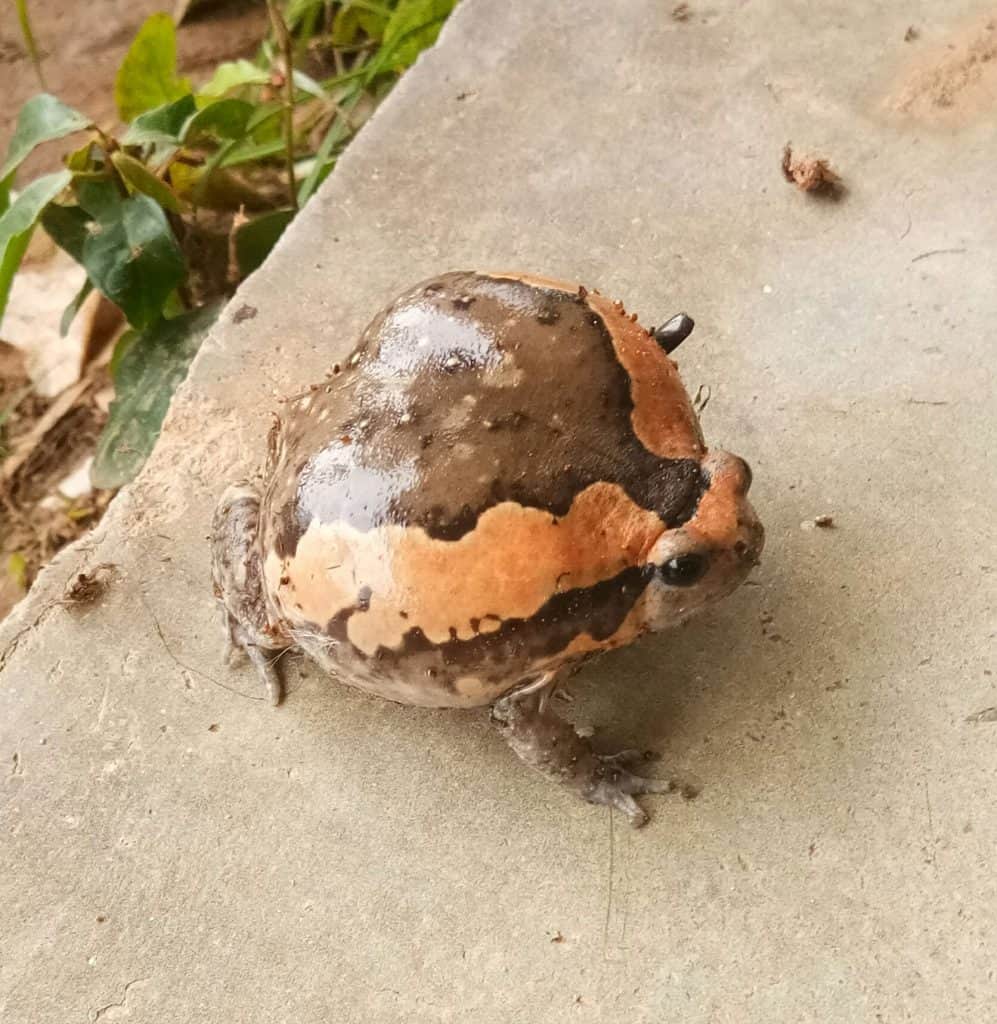
They may also secrete a sticky substance from glands in their skin.
This substance is not known to be toxic, but it does have an unpleasant taste. We don’t recommend trying it.
The one exception to this “look but don’t touch” rule is when handling is necessary to perform important health checks.
In these cases, ensure that your hands are clean and free of harmful chemicals (such as soaps or alcohol sanitizers) before touching your frog.
Do Chubby Frogs Make Good Pets?
A chubby frog pet is better off in its enclosure. It’s a poor choice for keepers looking to handle their pet.
Amphibians also have different care requirements to other kinds of pets, meaning that keepers must do their homework before bringing one home.
Still, the chubby frog is a hardy and adaptable amphibian that can be great to observe!
If you’re looking for a (relatively) hands-off amphibian that can live in a small space, the chubby frog is a great choice.
We hope you found our chubby frog care sheet interesting and informative!
Do you keep chubby frogs? Show us your frogs in the comments below!
